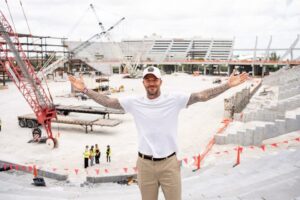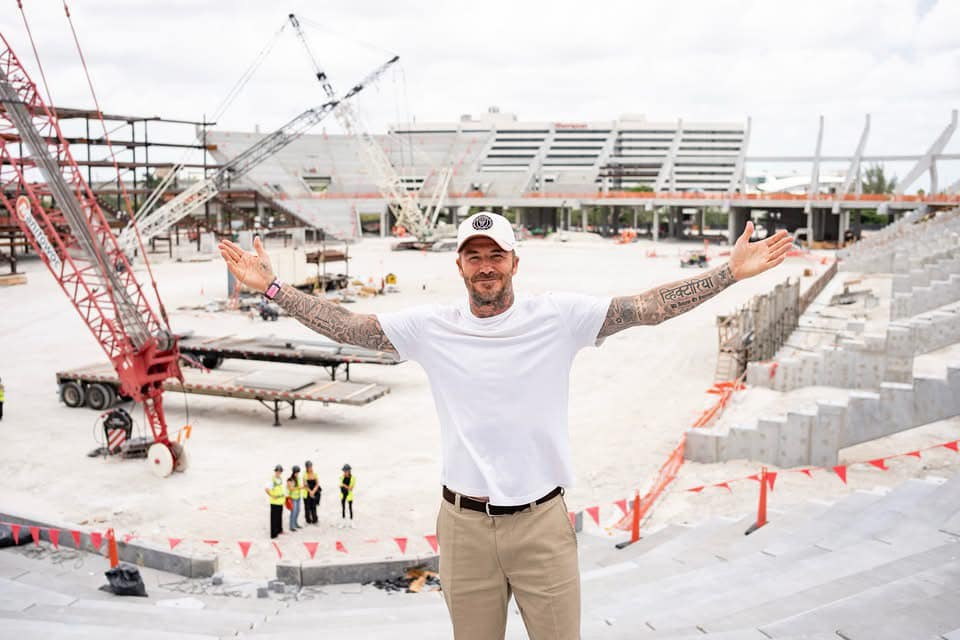Beckham’s Miami Masterpiece: The Untold Story of Building a Stadium Against All Odds

When David Beckham stepped onto the pitch for his first Major League Soccer game with the LA Galaxy in 2007, few could have predicted that his most challenging opponent wouldn’t be on the field at all. It would be the city of Miami itself—a beautiful, complex metropolis that would test the football icon’s resolve, patience, and determination like nothing before.
The Dream Begins
The seed was planted in Beckham’s MLS contract: an option to purchase an expansion team for just $25 million. It was a sweetheart deal, a reward for bringing his global star power to American soccer. But choosing a location was the easy part. Miami, with its international flair, Latin American connections, and vibrant culture, seemed like the perfect canvas for Beckham’s vision of bringing world-class football to the United States.
What followed was not the triumphant stadium ribbon-cutting that Beckham had imagined. Instead, it became a seven-year odyssey through bureaucratic labyrinths, political opposition, community backlash, and enough setbacks to make even the most determined entrepreneur consider walking away.
The Search for Sacred Ground
Between 2014 and 2018, Beckham and his ownership group, which included telecommunications mogul Marcelo Claure and Japanese businessman Masayoshi Son, proposed no fewer than six different stadium locations. Each one seemed promising on paper. Each one crumbled under scrutiny.
PortMiami was the first casualty. The waterfront location offered breathtaking views and easy access, but port commissioners and cruise industry executives balked at giving up valuable land. Next came a site near Marlins Park in Little Havana, but the land deal collapsed amid allegations of impropriety and questions about whether fair market value was being offered to the city.
A proposed stadium at the former Melreese Country Club site near Miami International Airport faced fierce resistance from environmentalists concerned about displacing a public golf course. Another location in Overtown, a historically Black neighborhood, sparked community protests over gentrification fears. Residents worried that a gleaming stadium would price them out of their own homes.
Each rejection felt like a red card. Each setback made headlines questioning whether Beckham’s American soccer dream was nothing more than an expensive fantasy.
The Political Minefield
Miami’s complex political landscape proved more treacherous than any Premier League rivalry. City commissioners changed. Mayoral administrations shifted. What one political leader supported, another opposed. Community groups organized. Lawsuits were filed and threatened.
The lowest point came in 2017 when a referendum to approve the Melreese site was blocked by legal challenges. Beckham, typically composed in front of cameras, admitted his frustration. “This has been a lot harder than I ever imagined,” he confessed in interviews. “But we’re not giving up.”
Behind the scenes, the costs mounted. Legal fees, consultants, architects who drew plans for sites that would never be built—the expenses ran into millions before a single shovel touched dirt. Some partners began to question whether Miami was worth the trouble.
The Breakthrough
The turning point came in 2018 with a revised proposal for the Miami Freedom Park project at the Melreese golf course site. This time, Beckham’s team took a different approach. Instead of just asking for land, they proposed a comprehensive development that would include the stadium, a hotel, retail space, a technology hub, and crucially, a public park that would be larger than the golf course it replaced.
The proposal addressed environmental concerns by promising to clean up contaminated soil. It offered community benefits agreements, including affordable housing contributions and local hiring commitments. Most importantly, it secured the backing of Mayor Francis Suarez and key commissioners who became champions for the project.
In November 2018, Miami voters approved the lease agreement in a referendum, with nearly 60% voting in favor. After four years and six failed attempts, Beckham finally had his site. But the battle wasn’t over.
Construction Challenges
Breaking ground in 2022 brought its own complications. Supply chain disruptions from the pandemic drove up costs. Hurricane season threatened construction timelines. Labor shortages meant scrambling for workers. The budget, initially estimated around $1 billion, swelled as inflation hit construction materials.
Yet through it all, Beckham remained hands-on. He wasn’t just a celebrity figurehead lending his name to the project. He attended planning meetings, reviewed architectural renderings, and consulted on every detail from the grass type on the pitch to the acoustics in the stands. This was personal.
A Cathedral for Soccer
The result, when it finally opened, was breathtaking. The stadium, with a capacity of approximately 25,000, was designed to create an intimate, intense atmosphere that would rival European football grounds. Unlike the cavernous, multi-purpose stadiums that plague American soccer, this was a temple built specifically for the beautiful game.
The architecture paid homage to Miami’s Art Deco heritage while embracing modern sustainability standards. Solar panels, rainwater collection systems, and native landscaping reflected a commitment to environmental responsibility that helped win over earlier critics. The sight lines were perfect from every seat. The luxury suites attracted corporate sponsors. The general admission sections created the kind of passionate fan environment Beckham remembered from his Manchester United days.
The Messi Effect
Just when it seemed Beckham’s vision was complete, he pulled off what many considered impossible: convincing Lionel Messi, arguably the greatest player in football history, to join Inter Miami in 2023. The signing transformed not just the team but validated everything Beckham had fought for.
Suddenly, the stadium that took seven years to secure was hosting one of the sport’s all-time greats. Games sold out instantly. Season ticket waiting lists stretched into the thousands. The international media descended on Miami. Apple TV’s streaming deal for MLS games suddenly looked genius. Beckham’s gamble was paying off in ways that exceeded even his ambitious expectations.
Lessons from the Journey
Beckham’s stadium saga offers lessons that extend far beyond sports. It demonstrates the complexity of urban development in America, where private ambition must navigate public interest, environmental concerns, historical preservation, community rights, and political realities. It shows how even global celebrity and immense wealth can’t bulldoze through democratic processes—nor should they.
Most importantly, it reveals the power of persistence. A lesser figure might have abandoned Miami after the third or fourth rejection, finding an easier market in a smaller city desperate for attention. Beckham’s refusal to quit, his willingness to listen to critics and adapt his proposals, and his genuine commitment to creating something meaningful ultimately won the day.
The Legacy
Today, as fans stream into the stadium wearing pink Inter Miami jerseys emblazoned with Messi’s name, it’s easy to forget the years of struggle. But Beckham hasn’t forgotten. In interviews, he speaks candidly about the emotional toll, the moments of doubt, and the satisfaction that comes from overcoming obstacles rather than avoiding them.
The stadium is more than a sports venue. It’s a testament to vision meeting determination, a symbol of what’s possible when talent, resources, and stubborn persistence align. It’s proof that even in an age of instant gratification and short attention spans, some dreams are worth the long fight.
For Beckham, the kid from East London who became a global icon, building this stadium may be his greatest achievement—not because it was the most glamorous, but because it was the hardest. Against political opposition, community skepticism, environmental challenges, and economic headwinds, he built his masterpiece.
The beautiful game finally has a beautiful home in Miami. And it only took seven years, six failed attempts, countless millions, and the unwavering belief of a man who refused to accept defeat.
As Inter Miami continues to grow and the stadium becomes a landmark in the city’s landscape, Beckham’s Miami dream stands as a reminder that the most meaningful victories often require the longest battles. In football and in life, it’s not just about the final score—it’s about what you’re willing to endure to get there.
